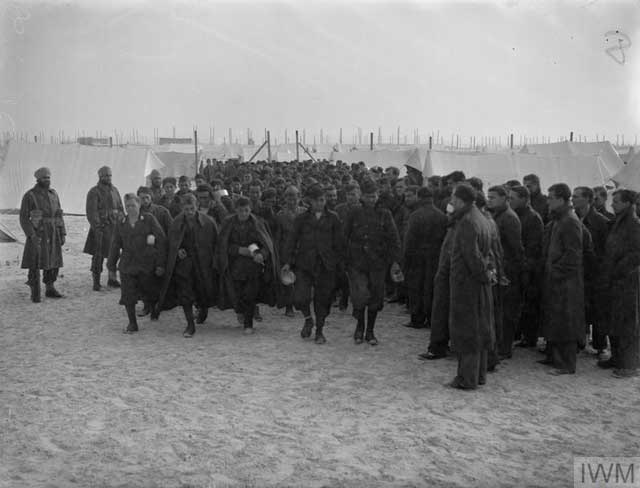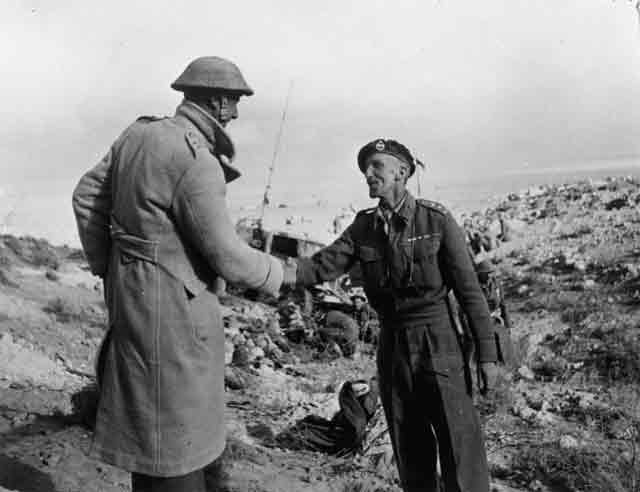Monday 29 December 1941
 |
| North American Aviation XP-51 41-038 at NACA Langley Memorial Aeronautical Laboratory, right profile. This plane arrives at Langley Field on 29 December 1941 for flight testing. (NASA). |
Eastern Front: As German Lieutenant General Hans Graf von Sponeck, commander of 42nd Army Corps, prepares to finish off the tenuous Red Army landings on the Kerch Peninsula on
29 December 1941, the Soviets spoil his plans. Units of the Soviet 44th Army arrives at Feodosia (Feodosiya) on the south coast of the Crimea at around 05:00. There are few German troops in the town and the landings are virtually unhindered. Nearby Germany artillery units score some hits on Soviet cruiser Krasnyi Kavkaz and Luftwaffe attacks sink a minesweeper and patrol boat, but the Red Army units secure the port by 07:30 and begin receiving artillery and vehicles. Sponeck quickly calls off the attacks near Kerch and instead redirects Romanian 8th Cavalry Brigade and 4th Mountain Brigade to contain the dangerous new threat in Feodosiya.
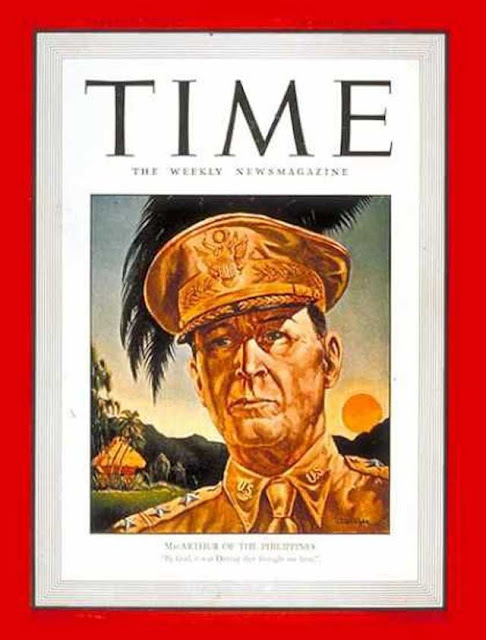 |
| General Douglas MacArthur on the cover of Time magazine, 29 December 1941. Covers such as this are quite rare and valuable if in good condition. |
Sponeck realizes that his troops far to the east of Feodosiya are now in great danger. He requests permission from 11th Army Commander General der Infanterie Erich von Manstein to withdraw the 46th Infantry Division - the only full division under his command - west beyond Feodosiya to avoid encirclement. Manstein refuses and orders Sponeck to counterattack with every available unit. Manstein also orders the 170th Infantry Division and part of the 73rd Infantry Division to the area to help in the counterattack. In a very rare act of open defiance to direct orders within the Wehrmacht, Sponeck shuts down communications with the 11th Army at 08:30, and orders the 46th Infantry Division west.
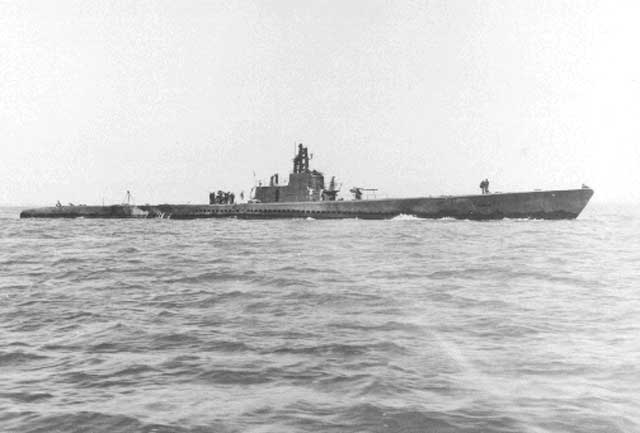 |
| On 29 December 1941, USS Swordfish, shown, becomes the last of eight U.S. submarines based in Manila Bay to depart for Australia. From this point on, U.S. submarines only return as blockade runners. Swordfish returns twice in February 1942 to evacuate Philippine President Quezon and other VIPs. |
Sponeck's order unquestionably saves the German troops but also eliminates any possibility of preserving the German position east of Feodosiya. This order eventually leads to Sponeck's court-martial and disgrace. General Manstein now beings a long, slow process of assembling troops on a north-south line on the Crimea, essentially abandoning the Kerch Peninsula for the time being until a large-scale counterattack can be prepared. In Feodosiya, the returning Red Army soldiers are later accused by the Germans of committing atrocities against any German soldiers, including wounded left behind in hospitals, who fall into their hands. This includes beating and mutilating German soldiers and throwing wounded men from hospital windows, then pouring cold water on them to freeze them to death. A dozen German soldiers hide out in cellars and other places of concealment awaiting rescue, and they later testify to this alleged activity by Red Army troops in Feodosiya.
 |
| "Mr. Churchill on the steps of Government House, Ottawa, acknowledging the greetings from the crowd." Churchill is in Ottawa from 29-31 December 1941. © IWM (A 6722). |
Further north around Moscow, the Germans also are in trouble. Army Group Center commander Field Marshal Guenther von Kluge feels hamstrung by Hitler's "no retreat" order. Kluge calls Hitler - not something that is ever done lightly, even by field marshals - and requests permission to order a general withdrawal. Kluge proposes to take the Fourth Army line due west of Moscow back about 10-15 miles. This, he says, will free three divisions for use shoring up the line further south at Yukhnov and Sukhinichi. Somewhat surprisingly, Hitler agrees after some back and forth, but limits the withdrawal to troops stationed at Kaluga. Kluge, who probably has accomplished more than he expected, sends the news to the local army generals. They, meanwhile, are somewhat bemused by this order because Kaluga already has been lost.
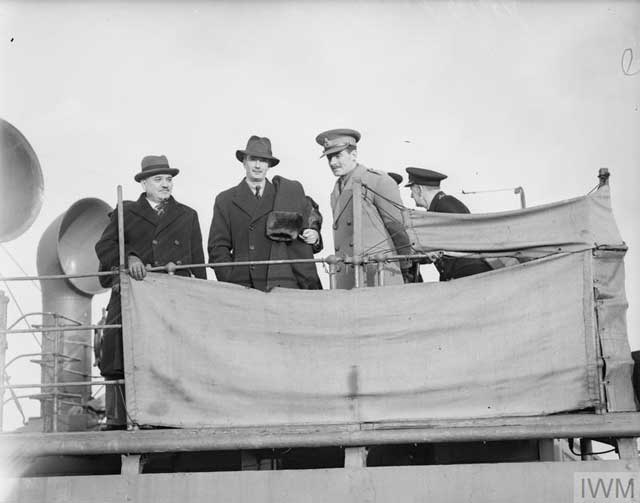 |
| "Mr. Anthony Eden, Mr. Maisky, Lieut General Nye, and Sir Alexander Cadogan on the bridge of the tender." This is their return from Russia to Princes Pier, Greenock on 29 December 1941. © IWM (A 6699). |
Battle of the Pacific: In the Philippines, the Japanese anticipate the US endgame in Luzon and bomb Corregidor for the first time. US General George Parker continues moving supplies as fast as possible out of Manila, now an open city but still under US control, to the Bataan Peninsula. Lieutenant General Douglas MacArthur hopes to create a redoubt for an indefinite length of time. However, there are few if any usable airfields in Bataan suitable for large forces. Japanese bombers raid Mariveles and damage converted submarine tender USS Canopus (AS-9), wrecking her propeller shaft and starting fires. All US submarines now have left Manila Bay. Major General Lewis H Brereton, Commanding General Far East Air Force, leaves the Philippines and arrives in Darwin, Australia. The new local commander of US Army Air Force units is Colonel Harold H. George. All he has left are units at Del Monte Field on Mindanao. These, however, are able to accomplish little, so George has little to do. Colonel (later General) George, incidentally, eventually becomes the namesake of George AFB, formerly Victorville AFB, California, which is about 74 miles northeast of Los Angeles.
 |
| The Winnipeg Free Press for 29 December 1941 announces the arrival of British Prime Minister Winston Churchill. |
In Borneo, the Japanese continue to advance from Kuching and take Singkawang. The British and Dutch troops in the area continue to retreat toward the Dutch airfield at Kotawaringin near Sampit and Pangkalanbun.
 |
| "The local inhabitants of Benghazi line the streets as the British troops arrive, 29 December 1941." The British captured Benghazi on 24 December. © IWM (E 7392). |
US/Chinese Relations: US Ambassador to China Clarence Gauss sends a
telegram to Secretary of State Cordell Hull on December 29, 1941, which references the Tulsa Incident. This is a misunderstanding that has arisen in Rangoon, Burma about the ownership of US Lend-Lease supplies destined for China. Local British officials have impounded these shipments from US freighter Tulsa on the theory that they need the supplies to try to hold Burma. Gauss notes that this has "aroused deep resentment on the part of Chiang against both America and Britain." Gauss suggests that "everything possible should be done by the British to make amends for their action" and that "it should be made known to Chiang that the matter has come to the attention of the President who confirms" that the supplies are for China, not the local British commanders. This is a seemingly minor diplomatic incident that has an outsized influence on future diplomatic relations between the three powers in Asia.
 |
| North American Aviation XP-51 41-038 in the collection of the Experimental Aircraft Association AirVenture Museum, Oshkosh, Wisconsin. (EAA AirVenture Museum). |
US Military: The first North American Aviation XP-51 fighter prototype, Air Corps serial number 41-038, arrives at the National Advisory Committee for Aeronautics Langley Memorial Aeronautical Laboratory, Langley Field, Hampton, Virginia, for flight testing. The RAF has placed an order for the plane, and this is the fourth production Royal Air Force Mustang Mk.I, RAF serial AG348 (North American serial number 73-3101). Testing of this plane lasts for a year, until 2 November 1942, and leads to the design of a new aileron. The engine is a liquid-cooled, supercharged 1,710.60-cubic-inch-displacement (28.032 liters) Allison Engineering Company V-1710-F3R (V-1710-39) single overhead cam 60° V-12 engine, with a compression ratio of 6.65:1 and a single-stage, single-speed supercharger. The XP-51, after much development and use of a new engine, becomes the legendary P-51 Mustang.
 |
| "U.S. Aerial Gunner" is the cover photo and story of the 29 December 1941 Life magazine. |
American Homefront: World War I ace and Indianapolis Motor Speedway President Eddie Rickenbacker cancels the 1942 Indianapolis 500 due to the war situation.
Local authorities in California, Idaho, Montana, Nevada, Oregon, Utah, and Washington order all German, Italian and Japanese aliens to surrender contraband. Contraband is defined to include any weapons, binoculars, cameras, and short-wave radios.
 |
| A tourist snapshot of Freiburg im Breisgau showing the tram on Kaiserstraße. This was taken on 29 December 1941 by Italian embassy official Ugo Proietti. His photos show undamaged cities that wouldn't be like this for much longer (Federal Archive Bild 212-340). |
December 1941December 1, 1941: Hitler Fires von RundstedtDecember 2, 1941: Climb Mount NiitakaDecember 3, 1941: Hints of Trouble in the PacificDecember 4, 1941: Soviets Plan CounteroffensiveDecember 5, 1941: Soviets Counterattack at KalininDecember 6, 1941: Soviet Counterattack at Moscow BroadensDecember 7, 1941: Japan Attacks Pearl HarborDecember 8, 1941: US Enters World War IIDecember 9, 1941: German Retreat At MoscowDecember 10, 1941: HMS Prince of Wales and Repulse SunkDecember 11, 1941: Hitler Declares War on the USDecember 12, 1941: Japanese in BurmaDecember 13, 1941: Battle of Cape BonDecember 14, 1941: Hitler Forbids WithdrawalsDecember 15, 1941: The Liepaja MassacreDecember 16, 1941: Japan Invades BorneoDecember 17, 1941: US Military ShakeupDecember 18, 1941: Hitler Lays Down the LawDecember 19, 1941: Brauchitsch Goes HomeDecember 20, 1941: Flying Tigers in ActionDecember 21, 1941: The Bogdanovka MassacreDecember 22, 1941: Major Japanese Landings North of ManilaDecember 23, 1941: Wake Island Falls to JapanDecember 24, 1941: Atrocities in Hong KongDecember 25, 1941: Japan Takes Hong KongDecember 26, 1941: Soviets Land in the CrimeaDecember 27, 1941: Commandos Raid NorwayDecember 28, 1941: Operation Anthropoid BeginsDecember 29, 1941: Soviet Landings at FeodosiaDecember 30, 1941: Race for BataanDecember 31, 1941: Nimitz in Charge2020





